| Oracle® Enterprise Data Quality for Product Data Task Manager Reference Guide Release 5.6.2 Part Number E23612-01 |
|
|
View PDF |
| Oracle® Enterprise Data Quality for Product Data Task Manager Reference Guide Release 5.6.2 Part Number E23612-01 |
|
|
View PDF |
The Governance Studio runs a DSA job using a data lens currently deployed into production or development. The results of the DSA are a set of actionable items shown on the various output tabs in the Governance Studio. The Business User reviews the results, makes decisions about those results, and prepares some or all of the output for downstream processing. Tasks are created in the Governance Studio and can then be managed in Task Manager.

For complete details about using the Governance Studio application, see the Oracle Enterprise Data Quality for Product Data Governance Studio Reference Guide. This document presents Governance Studio examples in the context of the Task Manager management and processing.
In Governance Studio, the Review, Approve, and Route Output tabs are identified by a green checkmark icon adjacent to the name of the tab. These tabs contain output data in tabular format that correspond to a DSA output step.

Data in these tabs may be selected for output to a file, output to another tab in the Governance Studio, edited, emailed, or run as input to a synchronous job. The following figure illustrates the creation of a task from by checking one or more rows on a Review, Approve, and Route tab:
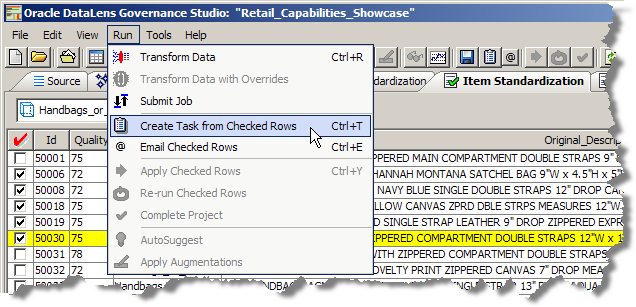
When you select the Create Task from Check Rows option, the Create Task dialog box appears as follows:
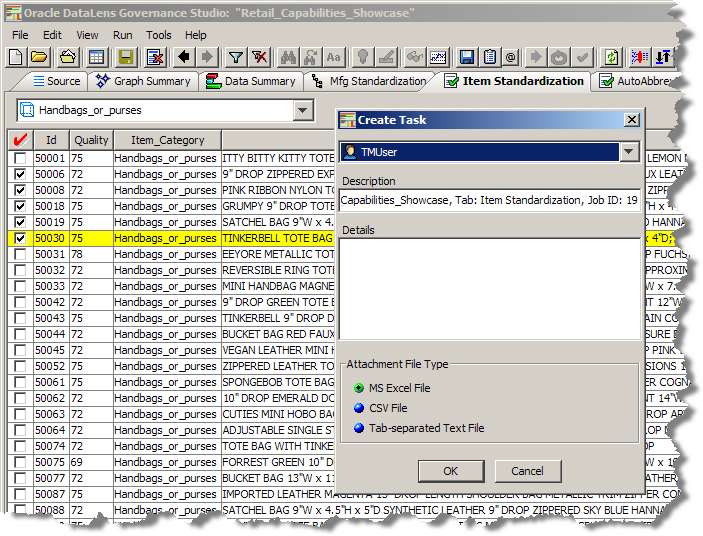
Note:
This Create Task dialog box is very different than the one described in Creating a Task in Task Manager because the DSA, DSA step, and data lens are already known.It allows you create and assign a task to a user as follows:
Select the user you want to assign the task to.
Enter a description for the task for display in all task lists.
Enter what you want the assigned user to do to complete the task; this is required and the task cannot be added without it.
Select the output file format for the contents of the selected rows from the following: a Microsoft Excel spreadsheet, CSV, or tab-separated text file.
Click OK.
The task is added and the assigned user receives an email advising them that they have a task to complete.
All tasks are displayed and are categorized by user as in the following example:
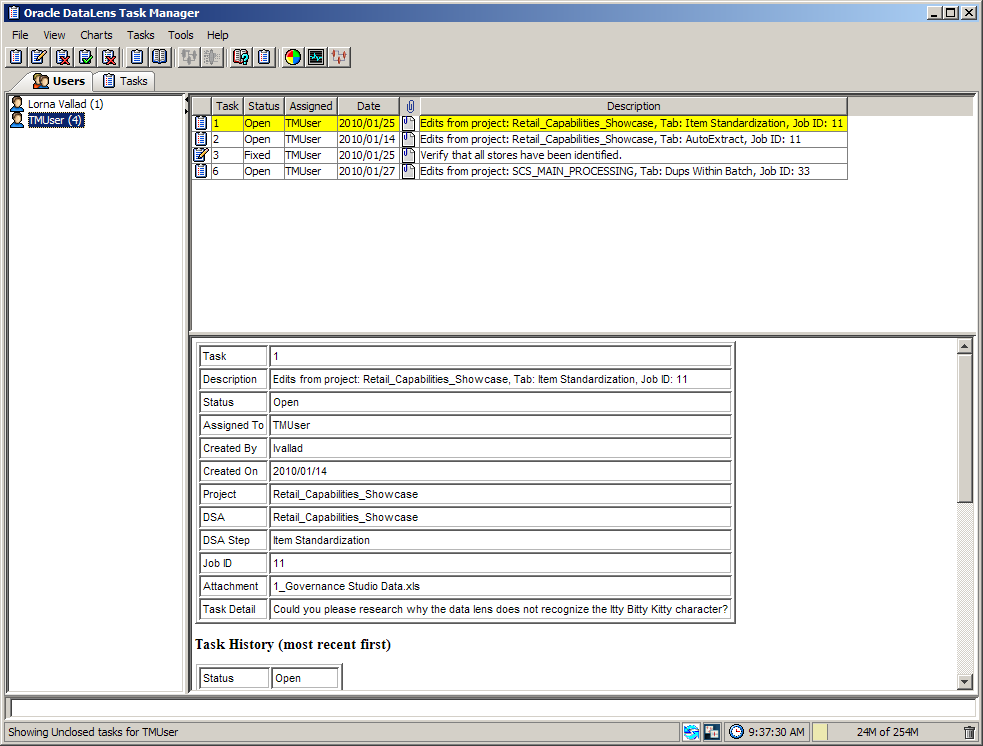
One of the ways to add a task is by using the AutoSuggest feature so that the Governance Studio automatically suggests attributes that may have been missed due to misspellings or abbreviations. Suggested data from the AutoSuggest process may then be transferred to an Output tab for further processing or the data can be sent by email or through a task to the Data Analyst to update the data lens in the Knowledge Studio. This section describes the use of AutoSuggest results for Task Manager processing.
A typical example of the AutoSuggest process is a Business User presented with a set of exceptions that did not meet the Quality Index threshold because some of the attributes were not present.
You can use the AutoSuggest feature in Governance Studio to leverage the Enterprise DQ for Product to offer a set of suggestions based on variants of known terms.

The AutoSuggest tab is identified by a light bulb icon to the left of the tab name. Data in these tabs may access the Governance Studio AutoSuggest feature that automatically predicts attributes that may have been missed due to misspellings and abbreviations or missing grammar. When this tab is populated, there are suggestions available and the AutoSuggest button is active. If no suggestions were found, this button is inactive.
After clicking on an AutoSuggest tab, you will also see a list of rows of data that were designated for output by the respective output step in the DSA. To view suggestions click on the AutoSuggest button on the menu bar. Suggestions are now colorized in green as shown in the following figure:

For more information about the AutoSuggest feature, see the Oracle Enterprise Data Quality for Product Data Governance Studio Reference Guide.
Double-clicking a cell in any of the output tables enables you to edit that cell. After double-clicking, notice that a text insertion cursor appears and the background of the cells turns to white.
Double-clicking a suggestion in an AutoSuggest table disables the suggestion and changes the color to pink. You can double-click again to re-enable the suggestion and return the colorization to green. In this way, you can choose which suggestions you want to keep and those to discard.
Right-clicking any cell colorizes the cell and displays a context-sensitive menu. Selecting the Jump to Source option automatically takes you to the corresponding line in the Source tab.
If you right click in a cell, you copy its contents to the clipboard by selecting the Copy Cell option from the context-sensitive menu.
You may select one or more rows to create a task for the Data Analyst to update the data lens. The following figure shows the green colorized terms in the description and the associated suggestions in the attribute columns on the right.

To do this, check the rows you want included in the task. From the menu, select Run and then click Create Task from Checked Rows.
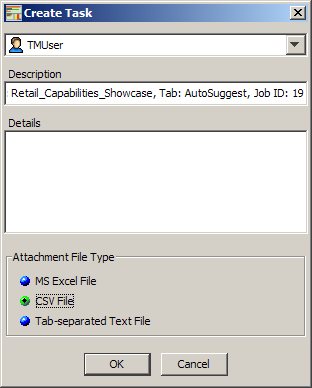
You complete this dialog box as described in "Creating a Task from an Output Tab" though the Description field is automatically populated for you with the name of the DSA, tab name, and the Job ID that it is assigned.
You can create a new task to be executed by a user from within Task Manager. This method is particularly useful when you want to view all of your available DSAs, each of their steps and data lenses rather than opening each DSA individually. To create a task, select Tasks from the menu bar and then click Create New Task.
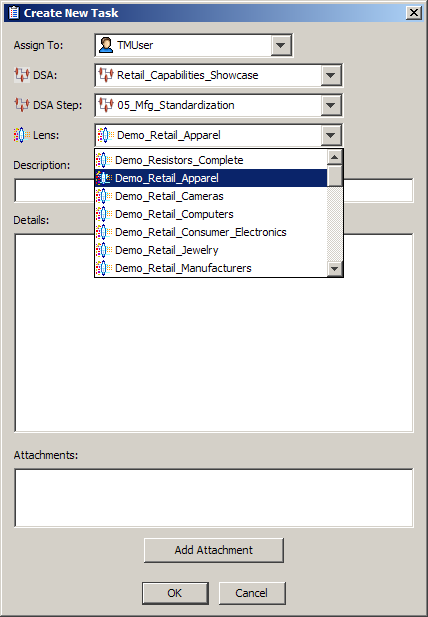
Complete this dialog as follows:
Select the user that you want assign the task to.
Select a DSA. This automatically populates the DSA Step and Lens drop-down lists with the corresponding selections based on the selected DSA.
Select a DSA step and data lens.
Enter a description for the task for display in all task lists.
Enter what you want the assigned user to do to complete the task; this is required and the task cannot be added without it.
The task details could include the steps to take, a basic outline of your intent for the task, or other information regarding the execution of the task.
Optionally, you can use the Add Attachment button to add any supporting files that are pertinent to the task. Locate the files of interest, select them, and then click Attach. More than on file can be added simultaneously using the Ctrl or Shift keys. Multiple files of varying file types are acceptable.
Click OK to add the task.
The task is added to Task Manager. An email is sent to the assigned user to alert them about it and is similar to the following:
Task: 0 Description: Edits from project: Retail_Capabilities_Showcase, Tab: AutoExtract, Job ID: 11 Status: Open Assigned To: TMUser Created By : TMUser Created On : DSA: Retail_Capabilities_Showcase DSA Step: Item Standardization Data Lens: Demo_Retail_Apparel Task Detail: Please see why the data lens does not recognize the Itty Bitty Kitty character?